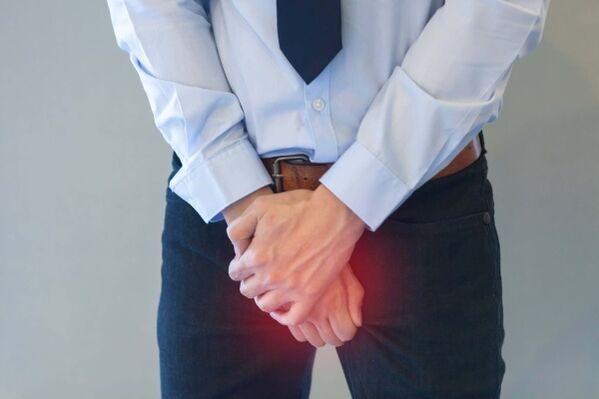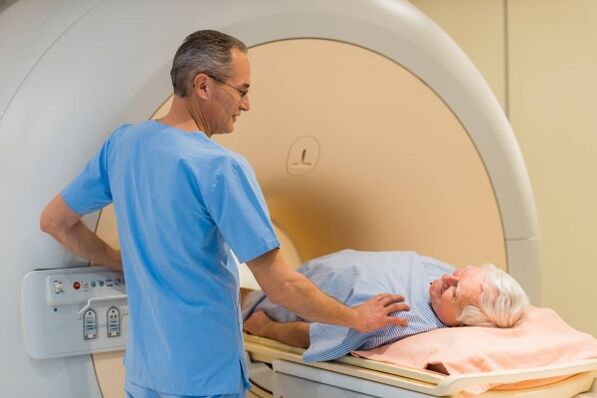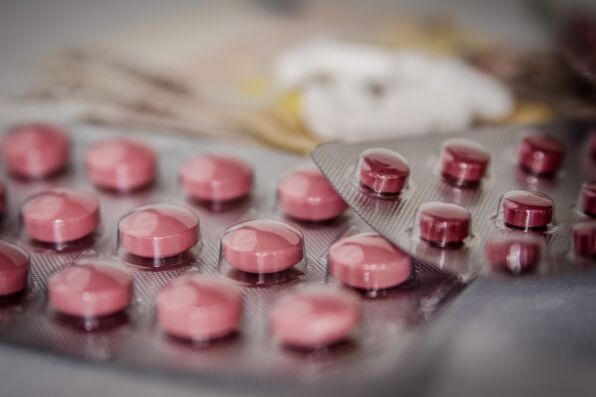Acute prostatitis is characterized by obvious clinical manifestations. Pathology is dangerous, there are many serious complications, so prompt and complicated treatment is required. This article describes how to identify and treat diseases.
Acute prostatitis is an inflammatory disease, accompanied by obvious pain, posing a great threat to health. For the successful prognosis of the disease, you should consult a doctor in time for diagnosis and prescribing a qualified treatment prescription.
General characteristics of the disease
Acute prostatitis is a rapidly developing inflammatory process in the prostate. It has four stages of development:
- Cathar.At this stage, the gland is slightly swollen and inflammation only affects the mucous membrane of the gland's excretory duct. This period is the most favorable moment for treatment-if you start at this moment, you can get rid of the disease in less than two weeks. The nature of the inflammation is not purulent, but the appearance of edema that blocks the ducts and prevents secretions from leaving the glands. The stagnation begins.
- Hair follicles.Due to the stagnation, the bacteria entering the organs have already begun to move in them. Since organs are composed of cells, divided into lobules and separated by connective tissue, inflammation affects one part first.
- substance.Inflammation spreads from one lobule to another, and there are many pustules in different parts of the gland.
- Suppurative abscess.The pustules merge into one, forming a bladder full of purulent contents in the gland. Over time, it ruptures and the pus spreads into the space around the prostate and bladder, urethra, or rectum. When the abscess is opened, the pus does not completely flow out, which becomes a new round in the inflammation process.
The development speed and ending method of the pathological process depend on many factors: the cause of inflammation, the timeliness and appropriateness of treatment.
reason
In 90% of cases, the cause of acute inflammation of the prostate is infectious disease. The pathogen can be one or several types of bacteria and viruses:
- Neisseria gonorrhoeae is one of the most dangerous bacteria, they will quickly start the purulent process.
- Trichomonas is a leader among sexually transmitted microorganisms. Penetrates into the intercellular spaces of the glands, so long-term stubborn treatment is required.
- Chlamydia-In addition to their toxicity, they can also bind red blood cells, increase their precipitation rate and hinder blood circulation in the affected area. They penetrate deeper than Trichomonas.
- Staphylococcus aureus is particularly common. It can survive in any tissues and organs, cause suppuration and thicken the blood.
- Ureaplasma is a cross between a single cell and a virus. Can enter the prostate from the urinary tract or unprotected intercourse.
- Escherichia coli is a gram-negative bacterium and a common pathogen of acute inflammation. Due to insufficient hygiene during food preparation, it can enter the human body.
This is not a complete list of bacteria and viruses that can cause acute inflammation of the prostate.
Usually the reason is not only that the infection can survive long-term in the body with almost no symptoms. When there are contributing factors, they begin to develop rapidly:
- Periodic or one-time hypothermia. Cold can weaken the body's defenses, and it is more difficult for them to contain pathogenic bacteria, especially if hypothermia is related to daily work.
- Irregular sex life. The stagnant secretion of the glands (which are part of sperm) promotes the reproduction of bacteria.
- Run the infection. These may be infections caused by unprotected sex, or they may be bacteria that cause mild inflammation of the urinary tract. Inflammation may also occur as a consequence of incompletely healed purulent sore throats in the form of streptococci. Even tooth decay can cause prostatitis.
- Weakened immunity. If due to disease or uncontrolled intake of antibiotics, the body's defenses are insufficient, bacteria will definitely show up.
- Failure to comply with personal hygiene rules.
Symptoms of acute prostatitis
The symptoms depend on the stage of the disease.
During catarrhal prostatitis, there is slight discomfort and heaviness in the perineum, and the urge to go to the toilet at night becomes more frequent. Urination is accompanied by burning and pain. The gland itself is normal or not severely enlarged, and palpation can cause pain. The temperature remained normal or slightly increased. No poisoning, overall health.
There are more manifestations in the follicular phase. The pain increases, becomes constant, and sometimes radiates sharply to the penis, sacrum, or rectum. Urinary retention occurs because of acute pain and difficulty urinating. Defecation is also accompanied by severe pain.
The temperature rose to 38 degrees and remained at this level. The prostate is obviously enlarged, dense, and in a state of tension. Touching it in certain places can cause severe pain.

Parenchymal prostatitis is very difficult. Appetite disappeared, chills appeared, and the whole body was weak. Frequent urinary urgency is replaced by acute urinary retention. Due to the unbearable pain, it is almost impossible to empty the bladder or bowel. It will be aggravated by constipation and bladder filling, spreading to the entire perineum, and it can only be slightly relieved in the prone position with the legs curled up.
The temperature rose above 39 degrees. The inflammation begins to spread to other organs, secreting mucus from the rectum. The outline of the prostate is unclear, swollen and painful. It may not be palpable due to edema.
The formation of an abscess is accompanied by the location of acute pain points-where the abscess appears. The excretion of urine, feces and gas is extremely difficult, accompanied by severe pulsating pain that spreads to the intestines. Body temperature remains above 39. 5 degrees, chills, fever, and sometimes delusional state.
Then, unexpectedly, relief came: the pain disappeared and the temperature dropped. However, this does not mean that the patient has recovered: the fact is that the abscess has ruptured and now urgent surgery is needed to remove the pus from the body, because the negative consequences can be very diverse.
diagnosis
The diagnosis is based on the evaluation of the patient's main complaint, analysis of urine, blood, and prostate secretions. In addition, they also use digital rectal diagnosis, ultrasound and CT methods.
Use urometry to assess the severity of urinary system diseases.
When the characteristic symptoms are still absent, a general analysis of urine allows you to identify the disease at the earliest stage. The alkaline acidity index itself indicates the development of inflammation.
A bacteriological examination of the urine allows you to determine the nature of the inflammation and its cause. Changes in urine color, smell, or consistency are not considered absolute evidence of acute prostatitis.
A complete blood count is the basis for the study of diseases. The characteristic indicators of acute prostatitis are low hemoglobin levels (normally 130 g/l), high urea and creatinine levels, as well as white blood cell levels and erythrocyte sedimentation rate. Protein should not be normal, and high levels of white blood cells-should not exceed 5 units.
The specific analysis of PSA allows you to identify not only inflammation but also malignant formation.
PCR research allows you to quickly identify any genital infections that are usually the cause of acute prostatitis.
Ultrasound allows you to determine the size, edges, points, and the presence of diffuse changes in the prostate. If an abscess has formed, this study can determine its size and location. If possible, the study will be conducted through the rectum; if pain and swelling do not allow this, study the glands from the side of the abdomen.
Sometimes ultrasound is performed by observing changes in the frequency of sound reflected from organs. This allows you to assess the blood supply of the prostate-vascularization, which can increase or decrease depending on the type of inflammation and its stage. Allows you to distinguish between cancerous tumors and acute prostatitis.
If the doctor determines that surgery is needed, he or she will order CT or MRI to check the details of the inflammatory process.

Treatment of acute prostatitis
Disease treatment is always complicated, including taking different drugs, procedures, and diet. Treatment can last about 2 months.
The main task of a doctor is to eliminate the cause of inflammation, the most common being infection. For this, antibiotics (alone or in combination) are prescribed. The choice of medication depends on several factors:
- Sensitivity to pathogens;
- The patient’s concomitant disease;
- The mode of action of the drug.
Inability to self-diagnose and treat: choose effective drugs based on laboratory tests
In order to combat the pathogens of the acute inflammatory process, fluoroquinolones and third-generation cephalosporins are most commonly used. For the treatment of acute prostatitis, the bactericidal effect of antibiotics is very important.
According to the patient's stage and condition, choose the dosage and release form of the drug: the more overlooked, the higher the dosage, and the faster the drug reaches its destination, the more important it is. Therefore, the injection form of the drug is better than the tablet.
It is necessary to normalize the outflow of urine and secretions. If urinary retention has become an acute form, a trocar extracapsular ostomy is prescribed-puncture the bladder and then introduce a thin tube.
If such drastic measures are not needed, non-steroidal anti-inflammatory drugs can be prescribed to restore normal urination, thereby eliminating swelling and pain. These drugs are prescribed in the form of tablets, injections or rectal suppositories.
If acute prostatitis has become an abscess, treatment depends on its stage. Active treatment with antibiotics and immunostimulants during the infiltration phase. Give analgesics to the block to help the patient overcome the pain.
If an abscess has formed, it can only be treated with the help of surgical intervention: open, clean the purulent bladder and install a drainage tube. After the operation, treatment is prescribed to combat microorganisms and poisoning.
The treatment of acute prostatitis is not limited to relief of symptoms. The course of antibiotics must be drunk to the end until the pain disappears.
After the seizure itself has resolved, it is time for physical therapy. It includes UHF and microwave procedures, electrophoresis and prostate massage. The goal is to relieve the swelling (if it stays) and improve the outflow of glandular secretions to avoid congestion.
It is important to stick to your diet throughout the treatment. You must reject the following products:
- Alcoholic beverages, coffee, fried and salted-cause the appearance of congestion;
- Cabbage, apples, beans, and raw vegetables-cause abdominal distension, which compresses the pelvic organs, including the prostate;
- Acidic drinks, internal organs-they can irritate the urinary tract.
The diet should include cereals, stewed vegetables, dairy products and baked fruits. All of these contribute to the normal functioning of the intestines. It is necessary to observe the drinking regime and drink at least 2 liters of liquids (water, fruit drinks, fruit juices) a day. The more frequent the urinary tract is flushed, the lower the risk of inflammation.
Vitamin complexes and peptides should be consumed to promote tissue regeneration and rapid recovery of normal gland function.

The favorable treatment process depends on the restoration of glandular tissue, the normalization of the chemical indicators of prostate secretion, the absence of pathogens in the analysis, and the general health of the patient.
Prognosis and complications
The sooner you start treatment, the quicker and easier it is to get rid of acute prostatitis. Complications are each next stage of the disease, the chronic course of the disease, the spread of inflammation to other organs, infertility, and sepsis. If the disease has already started, the gland itself may need to be removed.
Timely treatment, at the end of the treatment, the body's various functions are restored, and the working ability is fully restored.
prevention
Preventive measures include not having unprotected sexual intercourse (to rule out sexually transmitted infections), paying attention to hygiene, and promptly treating urinary tract inflammation. Be sure to maintain immunity, don't start caries, and be careful about any infectious diseases.
You should also rule out the factors that lead to the development of the disease. To do this, you need:
- Regular sex life with a partner;
- Avoid hypothermia (permanent and one-time);
- Quit drinking, smoking and sedentary lifestyle;
- Regularly receive routine examinations by urologists;
- Do not treat yourself at the first signs of the inflammatory process;
- Adhere to a balanced diet;
- Take vitamins, especially during the spread of infectious diseases.
Acute inflammation of the prostate occurs due to infections that occur under favorable conditions. Use antibiotics, anti-inflammatory drugs, painkillers, and vitamins for treatment. During treatment, it is important to adhere to the diet and drinking regimen.































